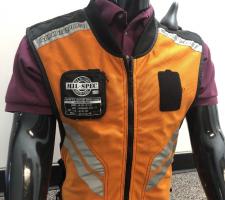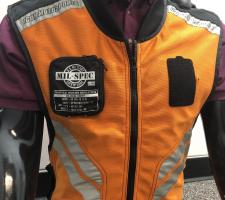
It’s not a lot of fun working on road maintenance or road construction worksites. By definition, you’re out in all weathers. You’re not popular with motorists, who blame you for hold-ups. It’s frequently physically arduous. And, worst of all, the sector has an unenviable record of injuries - even fatalities.
Often working just a metre or so from fast-moving traffic, maintenance and construction crews frequently have only the protection of warning trailers and plastic bollards to protect them from potentially lethal accidents. Much depends on private motorists or heavy goods vehicle (HGV) drivers being alert – especially on motorways, where the monotony of a journey can slow reactions.
To help ease this problem, German company Gewi is deploying a new system that integrates and disseminates advance warning of road workzones to approaching drivers through in-car systems.
The state has experienced two deaths among road maintenance personnel - in 2014 and 2017 - together with a large number of incidents. In recent years, for example, there have been seven to 10 instances per year of trucks colliding with warning trailers protecting workzones.
The priority for Saxony-Anhalt, said Ronny Dittrich, who is responsible for product management of Gewi’s workzone project, was to get information regarding the location of workzones in front of motorists – particularly truck drivers – to alert them as they approached road personnel.
“The idea was to use existing services that were in place, to combine systems and transmit information about those sites,” he said.
To do this, Gewi developed its own commercial, off-the-shelf software product. While not a workzone planning tool as such, TIC for Workzones can now be used from the earliest stages of developing a zone through to its completion and enables its precise position to be plotted on to digital systems.
Workzones can involve one or more highways agencies, together with the main contractor and a multiplicity of subcontractors. This raises issues about the uninterrupted flow of information.
“One problem that occurs worldwide is that information about workzones is typically managed very poorly, especially across various agencies,” noted Danny Woolard, business development director for Gewi for Europe and Australia.
TIC is designed to manage that communication process, from the early planning stages when a workzone is defined, initially managing the data to produce the necessary permits. This information can then be disseminated through multiple organisations.
Information on the precise location of a workzone, especially when it changes over the course of a lengthy project, is also gathered and disseminated to the public and across the internet – and specifically, in a format that can be understood and displayed by car navigation systems.
At last year’s ITS America exhibition, Gewi organised a demonstration with a US company that produces roadside beacons that can be attached to workzone bollards whose position can be accurately tracked. “This is becoming more and more relevant as we move towards automated driving,” noted Woolard.
Back in Germany, meanwhile, the Gewi system uses TIC to gather the necessary workzone information and pass it to the police, who in turn pass it to the nationwide public radio network, which broadcasts the information to in-car radios.
“The police use TIC already,” said Dittrich. “We just extended that to a more detailed level at the workzones. Everything interacts fluently. That allows the information [regarding workzone locations] to be sent to navigation and information systems in drivers’ cars within around two minutes.”
By mid-March every workzone warning trailer in Saxony-Anhalt was due to be equipped with the necessary equipment to allow its position to be sent over the system.
Additionally, the system is planned to be extended to two other federal German states, North Rhine-Westphalia and Hesse, both of which have high population densities and which already operate the TIC system.
Different approach
On the other side of the Atlantic, meanwhile, a different approach to workzone safety is about to be trialled.
The Center for Technology Implementation (CTI) at
VTTI is focused on helping agencies such as Virginia Department of Transportation to implement new technologies and has been looking at whether information could also go in the opposite direction – with roads personnel receiving information (perhaps through a cloud-based system) on vehicles as they near them.
CTI director Michael Mollenhauer noted that, in past projects, normal GPS processing had not been sufficiently accurate to reliably localise an individual’s position. And, as humans move in random ways, predicting their movements has always been difficult.
However, using real-time kinematic (RTK) correction gives a more precise GPS position – down to one metre or less. The idea would be to incorporate that improved GPS system into a vest that would then communicate its position to a connected vehicle. Potentially, it could also calculate the trajectories of people and cars.
VTTI has been looking at the possibility of collecting and interpreting the movements of workers when undertaking specific jobs, such as patching concrete or repairing barriers so that their likely behaviour could be understood and incorporated into the system.
“We’re trying to build the sensors into the vest so it’s not a burden to the wearer and is part of their standard PPE [personal protective equipment],” said Mollenhauer.
There have been three phases to the project, using different communication modes. The first was dedicated short-range communications; the second, ultra-wideband technology. “As technology developers, we try to be agnostic,” said Mollenhauer.
However, both methods had shortcomings.
Warning modes
A third approach is now under way using RTK GPS, with trials of the latest version of the vests scheduled to be held this summer. Built-in equipment will include lightweight, rechargeable and replaceable batteries, a vibrating haptic sensor plus LED flashing lights and speakers to provide audible warnings.
“Workzones are typically quite noisy and there are some visibility issues such as darkness and blowing dust, so dual modes are valuable,” Mollenhauer noted.
There is also an option of incorporating an inertial sensor that will give information on how workzone personnel are orientating themselves.
However, he is conscious of the possibility that some warning modes could startle staff at safety-critical moments, so he and his team are experimenting with methods of alerting personnel that could impart the necessary information without causing distraction.
If testing goes well, VTTI is planning to put together a package of intellectual property that can then be licensed to a manufacturer to produce the vests: “We believe we will have it ready for production around December 2019.”
One potential problem is the number of ‘dumb’ vehicles on the roads, older models that lack navigation systems or even radios capable of picking up automatic traffic broadcasts. However, the latter system has been incorporated into car radio systems since the mid-1990s, so it is a reducing factor.
Workzone crashes in US: rising numbers
Large trucks are responsible for a large, and growing, proportion of US workzone accidents in which people are killed, according to statistics from the Federal Motor Carrier Safety Administration.
Figures released in January this year noted that the percentage of fatal workzone crashes involving at least one large truck increased to 30.4% in 2017. This was an increase over the previous two years – 27.2% for 2016 and 26.8% in 2015.













